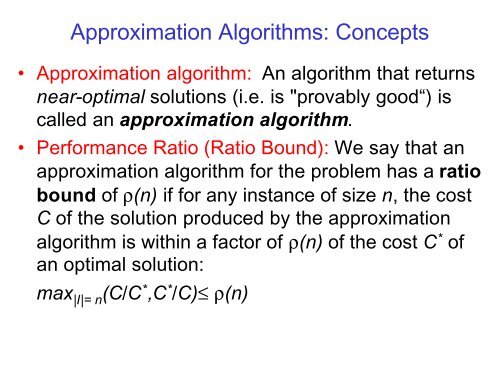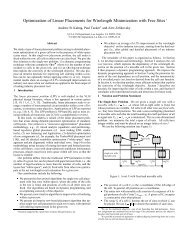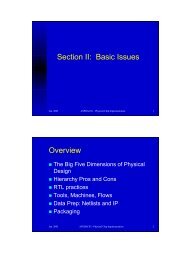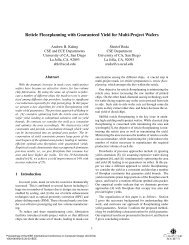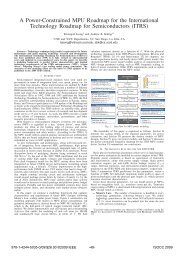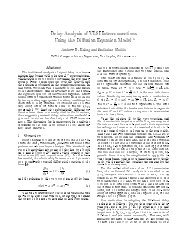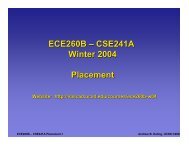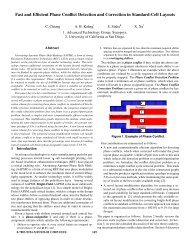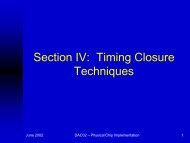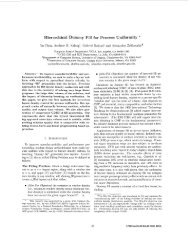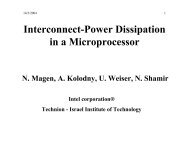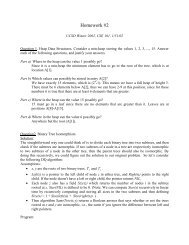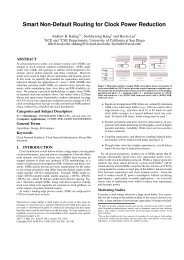Approximation Algorithms: Concepts - UCSD VLSI CAD Laboratory
Approximation Algorithms: Concepts - UCSD VLSI CAD Laboratory
Approximation Algorithms: Concepts - UCSD VLSI CAD Laboratory
You also want an ePaper? Increase the reach of your titles
YUMPU automatically turns print PDFs into web optimized ePapers that Google loves.
<strong>Approximation</strong> <strong>Algorithms</strong>: <strong>Concepts</strong><br />
• <strong>Approximation</strong> algorithm: An algorithm that returns<br />
near-optimal solutions (i.e. is "provably good“) is<br />
called an approximation algorithm.<br />
• Performance Ratio (Ratio Bound): We say that an<br />
approximation algorithm for the problem has a ratio<br />
bound of ρ(n) if for any instance of size n, the cost<br />
C of the solution produced by the approximation<br />
algorithm is within a factor of ρ(n) of the cost C * of<br />
an optimal solution:<br />
max |I|= n (C/C * ,C * /C)≤ ρ(n)
<strong>Approximation</strong> Algorithm : Euclidean TSP<br />
• Euclidean Traveling Salesman Problem: Let<br />
C 1 ,C 2 ,…,C n be a set of points in the plane<br />
corresponding to the location of n cities. Find a<br />
minimum-distance Hamiltonian cycle (traveling<br />
salesman tour) among them.<br />
• An MST-based approximation (ratio bound = 2)<br />
– Fact: cost(MST) < cost(Tour opt )<br />
Because: 1. SMT is the minimum-cost graph that<br />
connects all vertices, and has only n-1 edges. 2. any<br />
TSP tour must also connect all vertices, and will have n<br />
edges. Notice that a tour can be viewed as a spanning<br />
tree (that happens to be a chain) plus another edge.
<strong>Approximation</strong> Algorithm : Euclidean TSP<br />
– Idea: Consider the circuit that consists of a DFS<br />
traversal of MST (starting from any city), and<br />
includes an edge in the opposite direction<br />
whenever the search backtracks. And then we<br />
can take shortcut on the tour we get. Next slide<br />
is an example: DFS traversal starting from city a<br />
produces a circuit a-b-c-b-a-d… We can then<br />
use a shortcut c-d to replace original path c-b-ad.<br />
– Note: Being in a metric space (Euclidean is just<br />
one possibility) means that the triangle<br />
inequality holds, which means that the shortcuts<br />
reduce tour cost.
<strong>Approximation</strong> Algorithm: Euclidean TSP<br />
d<br />
a b c<br />
DSF traversal of MST<br />
Taking shortcut from<br />
DSF tour. (e.g.<br />
replacing a-b-c-b-a-d,<br />
by a-b-c-d)<br />
Tour Heur ≤ 2 * MST ≤ 2 * Tour opt
<strong>Approximation</strong> Algorithm: Euclidean TSP<br />
• Complexity of given approximation algorithm: The<br />
running time is dominated by MST algorithm,<br />
which, in the case of Euclidean graphs, is O(nlogn)<br />
• Performance Ratio of the given approximation<br />
algorithm: 2
<strong>Approximation</strong> Algorithm: Euclidean TSP<br />
• Improving the conversion from the tree traversal<br />
into a TSP tour: (Christofides 1976)<br />
– New way to look at previous conversion: we<br />
build an Eulerian circuit on top of the tree, by<br />
doubling each edge. Then we obtain the TSP<br />
tour by taking shortcuts from the Eulerian circuit.<br />
– Intuition: Tour_Heur has less cost than the cost<br />
of the Eulerian graph. So, if we can start with a<br />
lower-cost Eulerian graph, we will get a better<br />
bound⇒ Try to get a minimum augmentation on<br />
the MST, such that the resulting graph is an<br />
Eulerian graph.
<strong>Approximation</strong> Algorithm: Euclidean TSP<br />
– Definition:<br />
– What the Eulerian graph requires: every node’s degree<br />
is even.<br />
– Property of the tree: There must be even number of node<br />
with odd-degree. (Because the sum of nodes’ degree in a<br />
tree = 2 * # of edges in the tree)<br />
– Approach: Add exact one edge for each odd-degree<br />
node in the MST. In particular, find a minimum-cost<br />
matching among the odd-degree vertices of the MST,<br />
and then add an edge between every matched pair. The<br />
result is an Eulerian graph, which we then traverse and<br />
shortcut exactly as we did with the doubled MST.
<strong>Approximation</strong> Algorithm: Euclidean TSP<br />
The SMT plus the<br />
matching: the red line is<br />
the Eulerian circuit<br />
The tour obtained by<br />
taking shortcut from<br />
Eulerian circuit
<strong>Approximation</strong> Algorithm: Euclidean TSP<br />
• Consider optimal TSP tour. Nodes marked by<br />
triangles are odd-degree nodes in MST. The solid<br />
line represents the opt TSP tour. The red dashed<br />
lines and blue dashed lines represents two possible<br />
matching among those odd-degree nodes. .<br />
Either total length of blue lines or<br />
total length of red lines ≤ 0.5 *<br />
Tour opt . the minimum matching is no<br />
more costly than either the red or<br />
blue matching.If we use Min<br />
Matching, the distance of Eulerian<br />
graph will be no more than 1.5<br />
Tour opt .
<strong>Approximation</strong> Algorithm: Euclidean TSP<br />
• Ratio Bound of new approach: 3/2<br />
• Complexity: We have O(n^3) min-matching<br />
algorithm for general graphs (Gabow 1976 or<br />
Lawler 1976) and O(n^2.5(logn)^4) algorithm for<br />
Euclidean graph (Vaidya 1988).


